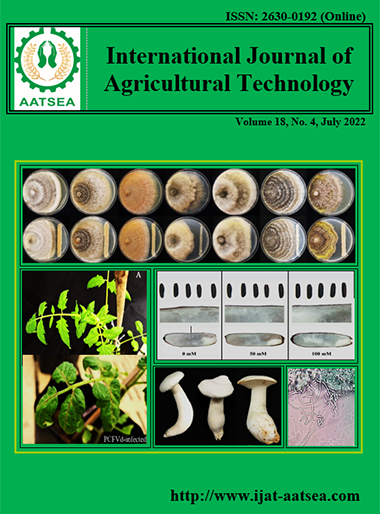Knowledge and practice following good agricultural practices (GAP) in Durian cultivation along the border in Srisakorn district, Narathiwat province
Main Article Content
Abstract
Results indicated that the farmers owning durian plantations had knowledge related to GAP in high level ( = 36.06). For practicing levels which followed eight items of GAP, the study found that highest rate to produce in the storage and transportation ( = 1.89), and the second-highest rating was used for agricultural hazardous substances ( = 1.81). The lowest rating at moderate level was water resources ( = 1.19). Factors related to GAP were gender, education level, source of money, farming experience, advice from the extension officer, experienced knowledge exchange, and level of GAP knowledge. These were associated with sub-items of GAP with statistical significances at p-levels of 0.01 and 0.05. Various stakeholders can use the results of this study for planning work urged the farmers to adopt practices which directly followed to GAP under the sub-items surveyed
Article Details

This work is licensed under a Creative Commons Attribution-NonCommercial-NoDerivatives 4.0 International License.
References
Agricultural Land Reform Office. (2013). Guideline for Good Agricultural Practice (GAP). Retrieved from https://www.alro.go.th/alro_th/article_attach/article_attach_201705011493613012.pdf
Benhong, Peng, Z., Xingchao, E., Ehsan, W. and Anxia. (2021). Evolution of spatial-temporal characteristics and financial development as an influencing factor of green ecology. Environment, development and sustainability, 1-21.
Ehsan, E., Cui, W., Sunil, K. J. and Huiming, Z. (2019). Estimation of realistic renewable and non-renewable energy use targets for livestock production systems utilising an artificial neural network method: A step towards livestock sustainability. Energy, 183:191-204.
FAO (2002). Smallholder Farmers in India: Food Security and Agricultural Policy. Retrieved from http://ftp.fao.org/docrep/fao/005/ac484e/ac484e00.pdf
Khaiman, P., Bunyasiri, I. and Sirisupluxana, P. (2016). Factors affecting the decision to enter GAP standards for durian growers in Chanthaburi Province. VIth National research presentation conference h, Sukhothai Thammathirat University, Thailand. pp.1-4.
Khin, Y. O. (2016). Case studies of Good Agricultural Practices (GAPs) of Farmers in Thailand. Center for Applied Economic Research. Kasetsart University Thailand. Retrieved from http://ap.fftc.agnet.org/ap_db.php?id=654&print=
Manked, P., Limunggura, T., In-go, A. and Chulilung, P. (2014). Adoption of Good Agricultural Practices by Durian Farmers in Koh Samui District, Surat Thani Province, Thailand. Conference: Society for Social Management Systems (SSMS), 1-5.
Ministry of Agriculture and Cooperatives (2021). Strategy of safety standard for agricultural products and food safety (2022-2027). Retrieved from https://www.moac.go.th/news-preview-431191791318
Narathiwat Provincial Office (2016). Food system strategy of Narathiwat Province (2021-2025). Retrieved from http://www2.narathiwat.go.th/nara2016/files/com_order/2020-07_cf8d8340a1aa1e0.pdf
National Research Council of Thailand (2015). Durian trade measures. Retrieved from www.trf.or.th.
Office of Agricultural Economics (2020). Agricultural economics data. Retrieved from https://www.oae.to.th/view/1
Suwanmaneepong, S., Kullachai, P. and Fakkhong, S. (2016). An investigation of factors influencing the implementation of GAP among fruit farmers in Rayong Province, Thailand. International Journal of Agricultural Technology, 12:1745-1757.
Thardphaiboon, P., Aungsuratana, A., Wanichkul, K. and Aroonrungsikul, C. (2013). Farmers’ perception on durian innovation: a case study of GAP-certified orchards in Chanthaburi Province, Eastern Thailand. Kasetsart Journal of Social Sciences, 34:152-161.


